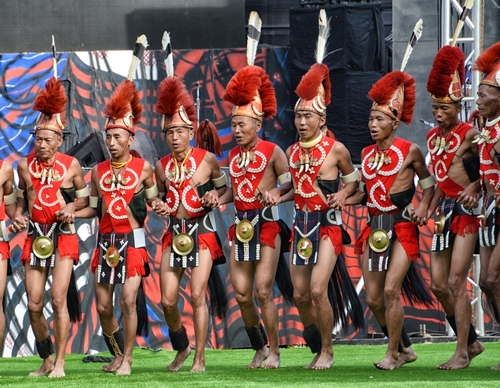For the Zeliangrong people of Northeast India, the Gaan-Ngai festival celebrated on Jan 1. 2026 is a vibrant and essential celebration that marks the end of the harvest season and the beginning of a new year. It is a time of immense joy, thanksgiving, and cultural pride, bringing communities together to honor their ancestors, share bountiful feasts, and celebrate their unique identity. As we look toward Gaan-Ngai 2026, we can anticipate a rich display of tradition that continues to thrive in the modern day.
History and Origins of Gaan-Ngai
Gaan-Ngai, which translates to “Festival of Winter,” is the most significant festival for the Zeliangrong people, an indigenous community comprising the Zeme, Liangmai, and Rongmei Naga tribes primarily residing in the states of Manipur, Assam, and Nagaland.
The festival’s roots are deeply tied to the agricultural cycle and the community’s animistic beliefs. Historically, it marked the end of the year’s harvest, a time to give thanks to the supreme deity, Tingkao Ragwang, for a plentiful season. It was also seen as a sacred period to honor the spirits of the deceased and ensure their peaceful journey to the afterlife. The rituals performed during Gaan-Ngai are meant to cleanse the community of misfortunes from the past year and welcome prosperity, health, and happiness for the year ahead. It is a beautiful blend of solemn ancestral reverence and joyous communal celebration.
How Gaan-Ngai is Celebrated Today
While traditionally a post-harvest festival, the date for Gaan-Ngai is now officially fixed on the 13th day of the Meitei lunar month of Wakching, which typically falls in December or January. The celebrations last for five to seven days, filled with elaborate rituals, colorful traditions, and lively community events.
Food and Feasting
Food is central to the Gaan-Ngai celebration. Families and communities come together to prepare and share grand feasts. Dishes often feature pork, chicken, and locally grown vegetables. A significant tradition is the preparation of special rice beer (Zou), which is offered to deities and ancestors before being shared among the community. The act of sharing food and drink reinforces social bonds and expresses gratitude for the year’s abundance.
Music, Dance, and Traditional Attire
The festival is a spectacular display of Zeliangrong culture. The air fills with the sounds of traditional music, including rhythmic drum beats and the singing of folk songs that tell tales of heroes, ancestors, and historical events.
Men and women, dressed in their finest traditional attire, perform spirited community dances. These garments are brightly colored and intricately woven, often adorned with symbolic patterns, beads, and shells. The dances, known as Hoi, are performed in unison and symbolize the unity, strength, and collective spirit of the community.
Rituals and Community Events
Gaan-Ngai begins with the ceremonial lighting of a sacred fire, known as Mairapmei, which is produced by rubbing bamboo and wood together. This fire is then distributed to every household to light their hearths, symbolizing a fresh start and the purification of the village.
Other key events include:
- Honoring the Ancestors: Families make offerings of food and drink at the graves of their departed loved ones.
- Youth Dormitories (Khangchu and Luchu): These traditional institutions play a vital role, organizing many of the festival’s activities, including games, competitions, and cultural performances.
- Games and Sports: Traditional games and sports are held, showcasing strength and skill. These events foster a sense of friendly competition and camaraderie.
Celebrations Among the Diaspora
For Zeliangrong communities living outside their native lands, Gaan-Ngai remains a crucial link to their cultural heritage. In cities across India and around the world, community organizations host celebrations that feature traditional food, music, and dance. These events are not only a way to pass traditions down to younger generations but also an opportunity to share their rich culture with the wider world, fostering a sense of pride and belonging far from home.
Evolving Trends in Celebration
In recent years, there has been a conscious effort to preserve and promote the traditions of Gaan-Ngai. Youth organizations are increasingly active in documenting folk songs, standardizing dance forms, and educating younger members about the festival’s deep cultural significance. While some rituals have been adapted to modern life, the core spirit of community, gratitude, and cultural identity remains as strong as ever.
The festival has also become a prominent cultural event that attracts tourists and researchers, offering them a glimpse into the rich traditions of the Zeliangrong people. This has helped raise awareness and appreciation for one of Northeast India’s most vibrant cultural celebrations.
Frequently Asked Questions (FAQ)
What is the main purpose of the Gaan-Ngai festival?
The main purpose is twofold: to celebrate the end of the harvest season and to honor the ancestors. It is a time for the Zeliangrong community to give thanks for their blessings, seek prosperity for the new year, and strengthen their cultural and communal bonds.
What are some traditional foods eaten during Gaan-Ngai?
Feasts are a major part of the festival. Common foods include dishes made with pork and chicken, various preparations of rice, and local vegetables. A special rice beer called Zou is also brewed and shared, playing an important role in both rituals and social gatherings.
What is the significance of the sacred fire (Mairapmei)?
The lighting of the sacred fire marks the beginning of the festival. It symbolizes purification, the chasing away of evil spirits, and the start of a new, prosperous year. The fire is shared with every household in the village, uniting the community in this symbolic renewal.
How long does the Gaan-Ngai festival last?
The festival typically lasts for five to seven days, with each day dedicated to specific rituals, feasts, and community activities, from honoring the dead to celebrating the youth.
Can non-Zeliangrong people participate in the festival?
Yes, guests and visitors are often welcomed with warm hospitality to observe and even participate in the public celebrations, such as the feasts and cultural performances. It is a wonderful opportunity to experience the rich culture of the Zeliangrong people.
